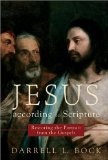Jesus According to Scripture: Restoring the Portrait from the Gospels. By Darrell L. Bock. Grand Rapids: Baker Academic, 2002. 704 pp. Cloth. $39.99.
This book is essentially a commentary on the four Gospels. The Synoptic Gospels are handled together and John by itself. Bock precedes one passage at a time.
This is a very impressive work. Bock manages to comment on key verses and to point the reader to the comments of other key scholars.
On texts that are soteriologically crux passages, Bock advocates what might be described as a mild Lordship Salvation position. His views on the following passages illustrate the point.
Matthew 16:24-28 and Parallels. “The shift in verb tense is important: two Greek aorist imperatives followed by a present. Self-denial and taking up the cross are fundamental commitments, while following Christ is a continual activity” (p. 233). The author clearly views these things are required not for discipleship and eternal reward, but for justification and eternal life. “One’s real, eternal life is too high a price to pay for temporary earthly acceptance” (p. 233). “The allusion to the Son of Man and glory refer to the final judgment” (p. 234).
John 15:6. While Bock mentions the view that the nonabiding branches are unfaithful believers who are disciplined, he rejects it. He gives four reasons why he believes that “abiding [is] equal to having life and nonabiding [is] lacking it” (p. 507). In his view the nonabiding branches are unbelievers who face eternal condemna-tion.
John 2:23-24; 8:30-32. According to the author “this belief turns out to be superficial, short-lived belief that is not true faith” (p. 466; see note 98 as well). For Bock true faith perseveres and never ends (see also pp. 452, 626).
John 20:30-31. Bock argues that the purpose of John’s Gospel is not merely evangelistic. “First, the goal is not simply belief, but also the life that results from belief…Second, then, the nature of what is covered in the Gospel as a whole indicates that John is after a full experience of the life that Jesus gives, not merely the decision to believe” (p. 549).
Repentance and Faith. In one section Bock gives a theological portrait of Jesus. Within this section he indicates that Jesus called for two responses: repentance and faith.
“Those who would enter the kingdom of God must appreciate their need for his direction and rule in their lives” (p. 625). Repentance for Bock is recognizing and acknowledging one’s “need for God and for coming to him on his terms…To come to Jesus is to have a change of perspective and direction about God from the path that one previously was traveling” (p. 625).
Bock then says, “A second key term of response is faith” (p. 625). Clearly faith is not the sole condition of eternal life. It is “a second key term of response.” This is not to suggest that Bock views faith as of lesser importance than repentance. For him both are equally important.
There are extensive Scripture and Subject indexes in the back of the book that are very helpful. These make it a very handy reference tool.
While JOTGES readers will not agree with the Lordship Salvation theology that comes through in places, this is nonetheless a book that most would find quite helpful.
Admittedly the discussion of individual passages is quite brief. However, enough is given so that the reader clearly sees where Bock stands and in many cases what other major views are possible as well.
I recommend this book.
Robert N. Wilkin
Editor
Journal of the Grace Evangelical Society
Irving, TX


